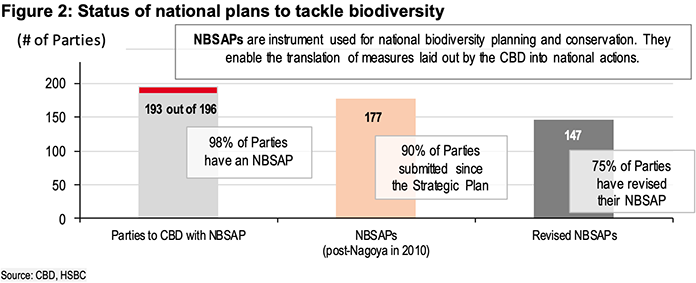- Article

- Global Research
- Understand ESG
COP15 on biodiversity
The Convention on Biological Diversity.
In the beginning: In short, biodiversity concerns the variability of all forms of life and their interaction within an ecosystem. Since human beings are dependent on our ecosystems for sustaining life, how the resources are managed is of great importance to economies, societies, livelihoods and the wellbeing of the planet.
What is CBD: The Convention on Biological Diversity (CBD) was adopted in 1992 and entered into force in 1993. The objectives of CBD are: “the conservation of biological diversity, the sustainable use of its components and the fair and equitable sharing of the benefits arising out of the utilization of genetic resources.”
Why CBD matters: Laying out the objectives is the simple part; implementing CBD in order to balance key principles as well as respect sovereignty and jurisdiction is much more challenging. It must cover conservation, monitoring, cooperation, financial resources and much more. It should be noted that CBD comes with sub-groups, bodies, reports and meetings – similar to the complexities of the UN’s Framework Convention on Climate Change. There are also a number of specific protocols that have been negotiated over the years that deal with particular aspects of CBD.
The basics: There are 196 Parties to the Convention on Biological Diversity. Notably, the United States has signed but not ratified the Convention; Iraq was the last Party to ratify (2009). There are two major sub-treaties: the Cartagena Protocol (on biosafety) which came into force in 2003, and the Nagoya Protocol (on access and benefit sharing) which came into force in 2014. It is a consensus-driven process which means that decisions are reached by the Convention as a whole (effectively unanimously). These decisions are guided by a host of sub-bodies and negotiating groups, the most notable of which are the subsidiary bodies on implementation and scientific advice. CBD tends to meet every two years although it was more frequent in the 1990s and COP15 has been delayed since 2020 due to the pandemic.
Figure 1: Timeline of the Convention on Biological Diversity
Implementation and reporting: The various principles of CBD, covering areas such as the identification and monitoring of relevant issues, the conservation of various components, are supposed to be implemented at a Party (i.e. national) level through National Biodiversity Strategies and Action Plans (NBSAP). In theory, these are supposed to be reviewed and revised periodically to incorporate the latest CBD decisions as well as be formally legislated into national laws and policies. Currently, 193 Parties have submitted at least one NBSAP (Fig 2). Success has been muted and biodiversity continues to deteriorate both globally and nationally.
Figure 2: Status of national plans to tackle biodiversity
Key outcome from Kunming: The first part of the COP15 meeting was held virtually during October 2021 and resulted in the Kunming Declaration. The declaration covers disappointment that previous targets have not been met, the recognition that biodiversity is closely linked to other environmental issues, the requirement for urgent action, and a call to action to lay the groundwork for a successful part two of COP15, especially the Post-2020 Global Biodiversity Framework (GBF).
COP15 part 1 thus mainly focused on building a foundation for the in-person (Part 2) meeting to take place in Montreal, Canada (7-19 December 2022). The overall ambition level of the GBF is still to be determined through targets and implementation; there needs to be a stronger approach to embed all the varying parts of the GBF (and not just certain targets such as protecting 30% of the planet by 2030). Similar to the Paris Agreement on climate change, the Post-2020 Global Biodiversity Framework would require more awareness (capacity building), technology and support as well as financial resources. The financial requirements are high with some estimates (Paulson Institute and Nature Conservancy) putting the figure at USD700bn per year. China announced the establishment of the Kunming Biodiversity Fund of CNY1.5bn (USD232m); it’s a start but an order of magnitude away from estimates of what is needed.
What biodiversity means for investors
There are many linkages to other issues such as climate change, water and pollution. It means, for instance, that investors seeking to understand the implications of climate change, and invest in solutions and adaptation, should understand biodiversity too.
Our 2nd ESG Sentiment Survey finds that almost three-fifths of the respondents are not actively looking at biodiversity as an investment – yet. We believe the general awareness of biodiversity is far below that of climate change and there is a lack of obvious investment options available. Anecdotally, we are receiving many more client questions on biodiversity.
Companies are increasingly being asked how they consider biodiversity in business operations; disclosure is on the agenda; progressive investors are beginning to engage.
First published 5th September 2022.
Would you like to find out more? Click here* to read the full report (you must be a subscriber to HSBC Global Research).
To find out more about HSBC Global Research or to become a subscriber get in touch at askresearch@hsbc.com.
* Please note that by clicking on this link you are leaving the HSBC Commercial Banking website, therefore please be aware that the external site policies will differ from our website terms and conditions and privacy policy. The next site will open in a new browser window or tab.
The following analyst(s), who is(are) primarily responsible for this document, certifies(y) that the opinion(s), views or forecasts expressed herein accurately reflect their personal view(s) and that no part of their compensation was, is or will be directly or indirectly related to the specific recommendation(s) or views contained in this research report: Wai-Shin Chan, CFA and Heidi Tang
This document has been issued by the Research Department of HSBC.
HSBC and its affiliates will from time to time sell to and buy from customers the securities/instruments, both equity and debt (including derivatives) of companies covered in HSBC Research on a principal or agency basis or act as a market maker or liquidity provider in the securities/instruments mentioned in this report.
Analysts, economists, and strategists are paid in part by reference to the profitability of HSBC which includes investment banking, sales & trading, and principal trading revenues.
Whether, or in what time frame, an update of this analysis will be published is not determined in advance.
For disclosures in respect of any company mentioned in this report, please see the most recently published report on that company available at www.hsbcnet.com/research.
Additional disclosures
- This report is dated as at 05 September 2022.
- All market data included in this report are dated as at close 02 September 2022, unless a different date and/or a specific time of day is indicated in the report.
- HSBC has procedures in place to identify and manage any potential conflicts of interest that arise in connection with its Research business. HSBC's analysts and its other staff who are involved in the preparation and dissemination of Research operate and have a management reporting line independent of HSBC's Investment Banking business. Information Barrier procedures are in place between the Investment Banking, Principal Trading, and Research businesses to ensure that any confidential and/or price sensitive information is handled in an appropriate manner.
- You are not permitted to use, for reference, any data in this document for the purpose of (i) determining the interest payable, or other sums due, under loan agreements or under other financial contracts or instruments, (ii) determining the price at which a financial instrument may be bought or sold or traded or redeemed, or the value of a financial instrument, and/or (iii) measuring the performance of a financial instrument or of an investment fund.
This document has been issued by The Hongkong and Shanghai Banking Corporation Limited, which has based this document on information obtained from sources it believes to be reliable but which it has not independently verified. Neither The Hongkong and Shanghai Banking Corporation Limited nor any member of its group companies (“HSBC”) make any guarantee, representation or warranty nor accept any responsibility or liability as to the accuracy or completeness of this document and is not responsible for errors of transmission of factual or analytical data, nor is HSBC liable for damages arising out of any person’s reliance on this information. The information and opinions contained within the report are based upon publicly available information at the time of publication, represent the present judgment of HSBC and are subject to change without notice.
This document is not and should not be construed as an offer to sell or solicitation of an offer to purchase or subscribe for any investment or other investment products mentioned in it and/or to participate in any trading strategy. It does not constitute a prospectus or other offering document. Information in this document is general and should not be construed as personal advice, given it has been prepared without taking account of the objectives, financial situation or needs of any particular investor. Accordingly, investors should, before acting on it, consider the appropriateness of the information, having regard to their objectives, financial situation and needs. If necessary, seek professional investment and tax advice.
The decision and responsibility on whether or not to purchase, subscribe or sell (as applicable) must be taken by the investor. In no event will any member of the HSBC group be liable to the recipient for any direct or indirect or any other damages of any kind arising from or in connection with reliance on any information and materials herein.
Past performance is not necessarily a guide to future performance. The value of any investment or income may go down as well as up and you may not get back the full amount invested. Where an investment is denominated in a currency other than the local currency of the recipient of the research report, changes in the exchange rates may have an adverse effect on the value, price or income of that investment. In case of investments for which there is no recognised market it may be difficult for investors to sell their investments or to obtain reliable information about its value or the extent of the risk to which it is exposed. Some of the statements contained in this document may be considered forward looking statements which provide current expectations or forecasts of future events. Such forward looking statements are not guarantees of future performance or events and involve risks and uncertainties. Actual results may differ materially from those described in such forward-looking statements as a result of various factors.
This document is for information purposes only and may not be redistributed or passed on, directly or indirectly, to any other person, in whole or in part, for any purpose. The distribution of this document in other jurisdictions may be restricted by law, and persons into whose possession this document comes should inform themselves about, and observe, any such restrictions. By accepting this report, you agree to be bound by the foregoing instructions. If this report is received by a customer of an affiliate of HSBC, its provision to the recipient is subject to the terms of business in place between the recipient and such affiliate. The document is intended to be distributed in its entirety. Unless governing law permits otherwise, you must contact a HSBC Group member in your home jurisdiction if you wish to use HSBC Group services in effecting a transaction in any investment mentioned in this document.
Certain investment products mentioned in this document may not be eligible for sale in some states or countries, and they may not be suitable for all types of investors. Investors should consult with their HSBC representative regarding the suitability of the investment products mentioned in this document.
HSBC and/or its officers, directors and employees may have positions in any securities in companies mentioned in this document. HSBC may act as market maker or may have assumed an underwriting commitment in the securities of companies discussed in this document (or in related investments), may sell or buy securities and may also perform or seek to perform investment banking or underwriting services for or relating to those companies and may also be represented on the supervisory board or any other committee of those companies.
From time to time research analysts conduct site visits of covered issuers. HSBC policies prohibit research analysts from accepting payment or reimbursement for travel expenses from the issuer for such visits.
The Hongkong and Shanghai Banking Corporation Limited is regulated by the Hong Kong Monetary Authority.
© Copyright 2022, The Hongkong and Shanghai Banking Corporation Limited, ALL RIGHTS RESERVED. No part of this publication may be reproduced, stored in a retrieval system, or transmitted, on any form or by any means, electronic, mechanical, photocopying, recording, or otherwise, without the prior written permission of insert issuing entity name. MCI (P) 037/01/2022, MCI (P) 017/10/2021
Sustainability for businesses
Explore how we're supporting customers in their transition to net-zero.






